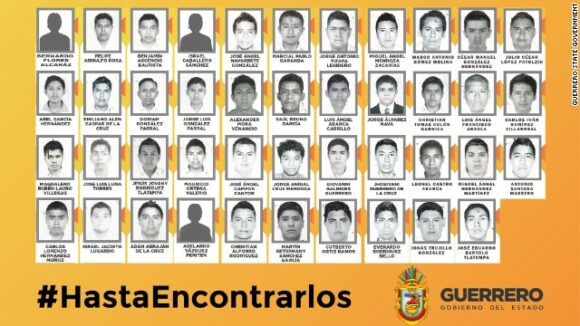The disappearance several weeks ago, and presumed murder, of 43 students from a teachers’ college in Ayotzinapa in the state of Guerrero has shocked the nation and sent shock-waves around the world. The isolated mountainous parts of the state of Guerrero have long been home to some of the worst violence and most severe poverty in Mexico. The students went missing in the town of Iguala on 26 September 2014.
We appreciate that many of our readers will already be well informed about recent events, but hope that the following summary, with its links to English-language sources, will be useful.
Mexico’s attorney general has announced that a drug cartel, operating in tandem with the mayor of Iguala and the mayor’s wife, had kidnapped and killed the students, before burning their bodies beyond recognition and dumping the remains in plastic bags in a river. According to some versions, local police were not only aware of the events, but complicit in them.
 Soon after the disappearance of the students, several mass graves were located on the outskirts of Iguala, but none of the remains has yet been positively identified as belonging to any of the missing students. However, the remains did include the body of a Roman Catholic priest from Uganda, missing since May 2014. John Ssenyondo, who had been serving in the region since 2010, was allegedly abducted by armed men for refusing to baptize the daughter of a suspected narco.
Soon after the disappearance of the students, several mass graves were located on the outskirts of Iguala, but none of the remains has yet been positively identified as belonging to any of the missing students. However, the remains did include the body of a Roman Catholic priest from Uganda, missing since May 2014. John Ssenyondo, who had been serving in the region since 2010, was allegedly abducted by armed men for refusing to baptize the daughter of a suspected narco.
- Priest’s body found in Mexico mass grave (Chicago Tribune)
Earlier this month, security experts searching the landfill site near the town of Cocula (where gang members allegedly killed and burned the students) found rubbish bags with human remains. The charred remains have been sent to a specialized laboratory in Innsbruck, Austria, for testing, but results will not be known for several weeks.
A judge in Guerrero has since charged the city’s former mayor, Jose Luis Abarca, with being the mastermind behind the students’ disappearance, and of responsibility for the murder of six people killed in clashes between the trainees, police and masked gunmen on the night of 26 September 2014. The government has detained more than 70 people in connection with the disappearance of the students. Maria de los Angeles Piñeda, the wife of the local mayor is alleged to be the head of the area’s major drug cartel. Abarca and his wife have both been arrested. The small town of Iguala, site of the murders, installed a new mayor, Luis Mazon, after the incumbent was arrested for ordering the massacre, but he resigned in disgust after only a few hours in office, to be replaced by Silviano Mendiola.
Bloody demonstrations are taking place across the country, threatening tourism and denting the carefully-crafted public relations image of President Enrique Peña Nieto.
In Chilpancingo, the state capital of Guerrero, 600 protestors set fire to cars, a congressional office and the city hall.
- Mexico missing: Guerrero state congress attacked (BBC)
- Mexico burns as protesters amp up violence over killing, kidnapping of 43 college students
- Mexico’s Missing Students: Guerrero Lawmaker Calls For Truce After Protesters Torch State Buildings
The tourist resort of Acapulco has also been the scene of demonstrations. For a short time protestors prevented flights from taking off from the city’s airport, and have also blocked highways. The hotel occupancy rates plummeted to 20% for a time, before beginning to rise again in recent days.
- Cancellation of hotel rooms in Acapulco (El Informador, Guadalajara: translated from Spanish]
In Mexico City, protestors set fire to one of the wooden doors of the Presidential Palace on the zocalo, Mexico City’s main square. The president has an office in the building but was leading a trade mission to China at the time.
Speaking to Fox News Latino recently, a student leader from the Ayotzinapa school said that, “It’s a national movement that’s launching. People are really upset in Mexico. It’s a movement for all citizens that is sparking protests across the country. That’s what happening now. We’re sending caravans to Chihuahua, Zacatecas, all the states from north to south. It’s family members [of the victims] and student-teachers.” The students also accept fire-bombings as a valid form of political expression.
Reactions in the USA have been mixed. For example, see:
- Op-Ed: Mexico reels, and the U.S. looks away (LA Times)
Sorry, the comment form is closed at this time.